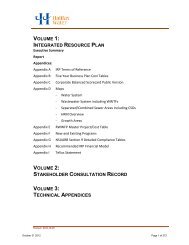Guidelines for the Preparation of Transportation Impact Studies - 8th ...
Guidelines for the Preparation of Transportation Impact Studies - 8th ...
Guidelines for the Preparation of Transportation Impact Studies - 8th ...
Create successful ePaper yourself
Turn your PDF publications into a flip-book with our unique Google optimized e-Paper software.
All o<strong>the</strong>r inputs should be based on data collected during <strong>the</strong> traffic study. Where adjustments<br />
are made, <strong>the</strong>y should be clearly outlined in <strong>the</strong> text <strong>of</strong> <strong>the</strong> report.<br />
Signal Timing Inputs<br />
Existing Phasing - Phasing plans <strong>for</strong> all existing signalized intersections are available from<br />
HRM Traffic and Right <strong>of</strong> Way. Call 490-4788 <strong>for</strong> detailed in<strong>for</strong>mation. These phasing plans<br />
must be used as inputs <strong>for</strong> base year calculations.<br />
Existing Phasing and Timing - Since traffic signal splits at <strong>the</strong> majority <strong>of</strong> intersections within<br />
HRM are controlled in response to vehicle demand, <strong>the</strong> cycle length in peak periods should be set<br />
at 120 seconds and splits adjusted to minimize overall delay.<br />
Proposed Phasing and Timing - Where <strong>the</strong> consultant proposes to change <strong>the</strong> timing or phasing<br />
<strong>of</strong> an intersection it must be demonstrated that <strong>the</strong> proposed changes will not negatively affect<br />
traffic flow. All changes should meet <strong>the</strong> following criteria:<br />
C a) <strong>the</strong> maximum cycle length used shall be 128 seconds (except <strong>for</strong> certain areas on<br />
Portland Street in Dartmouth and certain locations on Bed<strong>for</strong>d Highway). Cycle lengths<br />
should be in multiples <strong>of</strong> eight seconds.<br />
C b) <strong>the</strong> time allocated <strong>for</strong> a phase shall be equal to or greater than <strong>the</strong> internally calculated<br />
minimum walk time <strong>for</strong> a movement unless a pushbutton is provided.<br />
C<br />
C<br />
c) minimum pedestrian walk time is seven seconds.<br />
d) minimum pedestrian clearance time is calculated using a walking speed <strong>of</strong> 1.2 metres<br />
per second (or less <strong>for</strong> locations with significant numbers <strong>of</strong> senior citizens). The width<br />
to be crossed is from curb to curb at <strong>the</strong> middle <strong>of</strong> <strong>the</strong> crosswalk width. If <strong>the</strong> vehicle<br />
phase is longer than <strong>the</strong> pedestrian minimum time <strong>the</strong> excess should be made up in <strong>the</strong><br />
“walk” phase. Vehicle amber phase can be included, but only where absolutely<br />
necessary. All-red phase is not to be included.<br />
C e) standard amber time is 4 seconds, with rare 3 second locations. All-red time is from 1<br />
to 2.5 seconds, with 2 seconds being <strong>the</strong> most common. Solid advance green should be a<br />
minimum <strong>of</strong> 2 seconds. Amber arrow times are typically 4 seconds, with 4 seconds being<br />
<strong>the</strong> minimum.<br />
C<br />
C<br />
C<br />
C<br />
f) minimum vehicle green ball time is 10 seconds; <strong>for</strong> a turn arrow or flashing green<br />
phase <strong>the</strong> minimum time is 7 seconds.<br />
g) use lane widths in metres. If <strong>the</strong>re are varying widths <strong>for</strong> groups <strong>of</strong> lanes <strong>the</strong>n use <strong>the</strong><br />
average width.<br />
h) lagging phases are only permitted when <strong>the</strong>re are opposing protected left turns or<br />
where <strong>the</strong>re is no opposing turn movement such as at a “T” Intersection. (Avoid <strong>the</strong> “leftturn<br />
trap.”)<br />
i) where <strong>the</strong> intersection(s) in question is a part <strong>of</strong> a coordinated corridor <strong>of</strong> traffic<br />
signals, <strong>the</strong> consultant must demonstrate that <strong>the</strong> proposed changes will not affect<br />
progression along <strong>the</strong> corridor. We suggest using progression analysis programs such as<br />
Transyt 7F, or Synchro. If using Highway Capacity S<strong>of</strong>tware, set <strong>the</strong> progression factor<br />
to “2.”<br />
TISGUIDE8.WPD September 1, 2007 page B-4
















